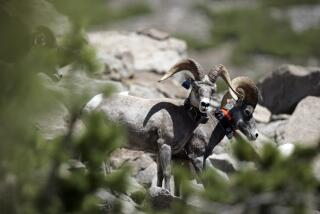Beast’s Horn Prized in Asia as an Aphrodisiac : Rise in Poaching Threatens India’s Rhino Population
- Share via
KAZIRANGA, India — The great Indian rhinoceros once roamed the Indian subcontinent from Afghanistan to Burma. The one-horned, three-ton beast was a favorite subject of artists in the Indus Valley civilization that flourished 4,000 years ago in what is now Pakistan.
By 1908, the number of the animals had declined to barely a dozen, here in the savannas and marshes of Assam in the far northeast corner of India. Most of the rest had been slaughtered by British sahibs looking for trophies and by Ahom tribesmen who thought that eating rhino flesh was a “sure passage to Heaven.”
A protection program initiated by the British and adopted enthusiastically by the Indian and Nepal governments has saved the Indian rhino, Rhinoceros unicornis , from extinction. And its number has increased.
Yet conservationists and park rangers in the Kaziranga National Park here, where two-thirds of the world’s estimated 1,500 Indian rhinos live, are concerned about increasing attacks by poachers who kill the rhino for its horn. Powdered rhino horn is much in demand as an aphrodisiac, mainly in Hong Kong and Singapore.
“The horn is nothing more than a collection of keratin tissue, just like our own hair,” Prafulla Chandra Das, the chief conservator of wildlife in Assam, told a recent visitor. “But wherever there is an ethnic Chinese population there is a demand for this horn.”
Horn poaching is also a serious problem in Africa, where the two-horned African rhino is found. The number of African rhinos is off sharply, mainly because of the aphrodisiac market, from 65,000 in 1971 to fewer than 8,000.
The horn of the Indian rhino has a much higher value. In Singapore, where the sale of rhino horn is legal despite pressure brought to bear on the government by world wildlife groups, Indian rhino horn has sold recently for as much as $7,000 a pound.
A single horn may bring as much as $10,000, and in India this is an enormous sum, about 40 times the annual per capita income.
Since the creation in 1908 of the Kaziranga National Park, which covers 269 square miles and is India’s largest, there has been a continuing problem with poaching, mostly by villagers. They dig pits along the rhino trails in the hope that a rhino will fall in and break its neck.
The park’s 200 patrol officers are mostly barefoot men in khaki shorts who make only about $50 a month, and feelings between them and the villagers are not exactly amicable. Still, until recently, the poachers and the patrolmen were able to reach a sort of ecological balance. Every year the poachers killed some rhinos, but the park’s rhino population continued to grow, and now stands at roughly 1,080.
“At that scale of poaching we were able to keep the population up,” Das, the wildlife conservator, said. But he added that in the past two or three years the scale and the nature of poaching in the rhino preserves has changed radically.
Instead of digging pits and hoping a rhino would fall in, the poachers are using high-powered, semi-automatic rifles. In August a park ranger was shot to death in a fight with poachers.
Before 1984, said Pramod Chandra Mahanta, the park’s chief ranger, about eight out of 10 rhinos killed by poachers were victims of the pits. Today, he said, eight out of 10 are killed by rifle fire. The rangers, who have one bolt-action rifle for every four-man patrol, are outgunned by the poachers, in terms of quantity as well as quality.
By late November, 35 rhinos had been killed in the park, seven of them in October alone. The poaching “season” has just begun, though, and the rangers fear a particularly bad year.
The park averages about 75 rhino births a year (rhinos produce only one calf at a time). Thirty-five to 40 rhinos die every year from natural causes and if the poaching rate increases much more, Mahanta said, the park could be facing a decline in numbers for the first time since 1908.
Das blames the new level of poaching on outsiders. “The big financiers are probably in Calcutta or Katmandu,” he said, and added that the arrest recently of two poachers led officials to one of the most prominent citizens of the nearby city of Nowgong, a man with clear links to Calcutta.
Das’ campaign to halt poaching is complicated by an Indian government ruling that prevents him from destroying or selling the horns of animals that die of natural causes. Before the ruling went into effect, the park sold 30 to 40 such horns a year, Das said, and the money was used for park improvements.
Now, most of the countries where the rhinoceros survives have agreed not to sell the horns of animals that die, in the hope that it will dry up the aphrodisiac market. But the Indian government, aware of the horn’s value, will not permit Das to destroy those he has, and this makes it necessary for him to mount a guard over them. These are men, he said, who could be used for other assignments.
At a secret location in Guwahati, the former capital of Assam, is a storehouse under 24-hour guard that contains 350 rhino horns valued at $2.5 million.
More to Read
Sign up for Essential California
The most important California stories and recommendations in your inbox every morning.
You may occasionally receive promotional content from the Los Angeles Times.













